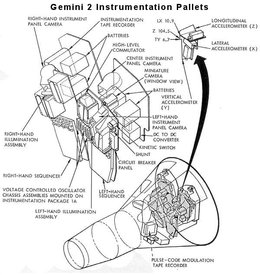Gemini 2
|
|
| Mission Insignia | |
|---|---|
| Missing image Gemini_Insignia.jpg Gemini 2 Insignia | |
| Mission Statistics | |
| Mission Name: | Gemini 2 |
| Call Sign: | Gemini 2 |
| Number of Crew: | 0 |
| Launch: | January 19, 1965 14:03:59.861 UTC Cape Canaveral LC 19 |
| Landing: | January 19, 1965 14:22:14 UTC Template:Coor dm |
| Duration: | 18 minutes, 16 seconds |
| Orbits: | Suborbital |
| Apogee: | 171.2 km |
| Distance Traveled: | 3,422.4 km |
| Mass: | 3,133.9 kg |
| Gemini 2 | |
Gemini 2 was an unmanned flight in the U.S. Gemini program. Gemini 2 was launched on a Titan II rocket. The flight was a suborbital test of various systems. It later became the first spacecraft flown into space twice when it was sent on an unmanned military mission.
The Titan II/Gemini launch vehicle had to be dismantled to protect it from 2 hurricanes in August and September of 1964. The 2nd stage of the vehicle was taken down and stored in a hanger on 26 August 1964 in preparation for Hurricane Cleo, but the entire launch vehicle was dismantled and removed from Pad 19 in early September before Hurricane Dora passed over Cape Canaveral on September 9th. The Gemini launch vehicle was erected for the final time on 12 September 1964.
Missing image S64-40298.jpg On 11-24-1964 Gemini 3 crew does egress training from Gemini 2 spacecraft. (NASA) |
Many ground tests were carried out on the Gemini 2 and Titan rocket in November, 1964. On November 24, 1964, Gemini-Titan (GT) 2 successfully completed the Wet Mock Simulated Launch, a full-scale countdown exercise which included propellant loading. Procedures for flight crew suiting and spacecraft ingress were practiced during simulated launch. The primary Gemini-Titan 3 flight crew donned the training suits and full biomedical instrumentation, assisted by the space suit bioinstrumentation and aeromedical personnel who would participate in the GT-3 launch operation. As a result of this practice operation, it was established that all physical examinations, bioinstrumentation sensor attachment, and suit donning would be done in the pilot ready room at complex 16. (See photo of GT-3 crew leaving GT-2 launch simulation).
Gemini II had been scheduled for launch December 9, 1964. On that date the countdown reached zero and the stage one engines were ignited. The launch vehicle's Malfunction Detection System detected technical problems due to a loss of hydraulic pressure and shutdown the engines about one second after ignition.
Gemini 2 lifted off from Launch Complex 19 at Cape Kennedy on January 19, 1965 at 9:03:59 a.m. EST (14:03:59.861 UT). It flew a ballistic suboribtal arch over the Atlantic Ocean reaching a maximum altitude of 171.2 km. The spacecraft was run by an onboard automatic sequencer. At 6 minutes 54 seconds after launch retrorockets were fired. The spacecraft landed 3,422.4 km downrange from Cape Kennedy, Florida. The flight lasted 18 minutes 16 seconds. The landing was 26 km short of the planned impact point, and 84 km from the recovery aircraft carrier, the U.S.S. Lake Champlain. The spacecraft was brought aboard the carrier at 15:52 UT (10:52 a.m. EST). Most goals were achieved except, the fuel cells had failed before liftoff and were turned off. The spacecraft cooling system temperature also was found to be too high. The Gemini 2 was in excellent condition. Its heat shield and retrorockets functioned as expected. The Gemini 2 mission was supported by the following U.S. Department of Defense resources; 6,562 personnel, 67 aircraft and 16 ships.
Gemini 2 had flight instrumentation pallets installed in the crew cabin, similar to Gemini 1.
The Gemini 2 reentry module was refurbished and flown again on November 3, 1966 in a test flight for the U.S. Air Force Manned Orbiting Laboratory program. It was launched on a Titan IIIC rocket on 33-minute suborbital flight from LC-40 at Cape Canaveral, Florida.
| Contents |
Instrument Pallets
Capsule Location
It is currently on display at the U.S. Air Force Space Museum, Cape Canaveral Air Station, Florida. Its guidance computer is held at the Smithsonian Air and Space Museum.
See also
External links
- Manned Space Flight Network Performance Analysis for the GT-2 Mission - NASA - May 14, 1965 (PDF format) (http://ntrs.nasa.gov/archive/nasa/casi.ntrs.nasa.gov/19650018359_1965018359.pdf)


